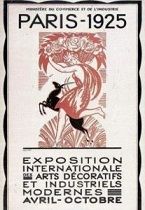The History of Art Deco
The seeds of the Art Deco movement were sown in the 1920s. In some ways it was a reaction to the older Art Nouveau style, yet it also had a lot in common with it. Art Nouveau was Modernist in the sense that it reacted to the idea of “art for art’s sake” prevalent in the traditional styles up to the late 1800s.
It tried to make a link between the art as the pursuit of artistic endeavour and art as a link to improving the lifestyles of ordinary people in the nascent age of consumerism. People wanted things that increasingly looked good and also did the job required.
 Art Deco took these ideas on board, yet it saw Art Nouveau as old fashioned and not really fit for purpose in an age of increasing mass production and machine technology. It was clearly from the 19th Century. They wanted to create a new style that served similar objectives, yet was more suited to the technology and lifestyles of the 20th Century. Instead they wanted to build on the developments of Bauhaus and the Cubist movements. It had to be a style that was forward looking, and one that appealed to aspiring middle classes. It could not simply be another style that intellectually rejected what had gone before in a way that most people couldn’t relate to.
Art Deco took these ideas on board, yet it saw Art Nouveau as old fashioned and not really fit for purpose in an age of increasing mass production and machine technology. It was clearly from the 19th Century. They wanted to create a new style that served similar objectives, yet was more suited to the technology and lifestyles of the 20th Century. Instead they wanted to build on the developments of Bauhaus and the Cubist movements. It had to be a style that was forward looking, and one that appealed to aspiring middle classes. It could not simply be another style that intellectually rejected what had gone before in a way that most people couldn’t relate to.
The real start of Art Deco followed meetings of a group of mostly French artists who formed an association called the “Societe des artistes Decorateurs” - shortened quickly to Art Deco. This group was supported by the French Government and a major exhibition was planned in Paris for 1914. Unfortunately for them World War I broke out and no further progress was made until 1925. Then a major exhibition was held which exhibited work from over 15,000 artists, architects and designers. The various buildings hosting parts of this exhibition hosted over 16 million people. Art Deco was truly with us now.
 Art Deco became a major Art Movement during the 1920s, but really reached its peak during the 1930s when America had truly taken it on board and developed its own variant of the style( often known as “Streamline Moderne”). It became very popular during that period in the public mind and hit its objective of being seen as a populist art form for a modern, stylish and forward looking culture. It was visually pleasing whilst not at the same time being intellectually threatening. It now represented modern machine based produced goods rather than the craft based items typical of the Art Nouveau period.
Art Deco became a major Art Movement during the 1920s, but really reached its peak during the 1930s when America had truly taken it on board and developed its own variant of the style( often known as “Streamline Moderne”). It became very popular during that period in the public mind and hit its objective of being seen as a populist art form for a modern, stylish and forward looking culture. It was visually pleasing whilst not at the same time being intellectually threatening. It now represented modern machine based produced goods rather than the craft based items typical of the Art Nouveau period.
Art Deco was dominant in the 1930s, but by the end of the decade a more negative culture had taken over and World War II broke out. The widespread destruction of europe after the War took a long time to overcome and austerity was the order of the day. Art Deco was a sophisticated extravagance. By the 1960s incomes and aspirations had grown again and Art Deco made a come back. It is still very popular up to the present day and had influenced many consumer products, architecture and design cues well into the digital age.












